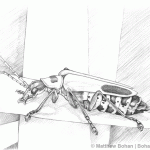I had someone ask recently about my sketching techniques and supplies. I thought I could summarize some of that here. The artists’ style may dictate the sketching material. There are probably as many opinions as there are artists.
You can tell a lot about artists by their sketchbooks. I’ve always loved looking through other artist’s sketchbooks. You can see how they solve problems, investigate shapes and build forms with simple lines and shading. Watching the pages develop as they study something is particularly fascinating to me. You can’t really hide behind anything in a sketchbook. If you are weak it shows. If you are strong it is just as apparent. As hard as it can be to part with some paintings, I’d never sell a sketchbook.
The Sketchbook
I’ve used a lot of different types over the years, from spiral bound, glued-edge paper backs to bound books like the ones in the photo. Each has their advantages. I have settled on the bound books for the past ten years or so. I’ll be the first to admit that they have a few disadvantages, but I really like them.
Hard cover bound books don’t flatten out well and thus are hard to photograph and scan into the computer. The binding has a tendency to crack if you try to flatten it out too much. At the very end of the book the pages want to curl up a bit. That makes the end of the book a bit harder to draw in. That is about all I can say that is negative about the bound books.
Now for the good things about hard bound sketchbooks. One of my favorite things about these books is probably a complaint of many people. If you rip a page out, you’ll be able to tell. You’ll have the ragged edge staring out at you, and the page connected by the binding might fall out. I kind of like the pressure of having to try to always be “on” in the sketchbook because I can’t simply tear out a page. It makes me work harder. As they say “pressure makes diamonds.” I don’t know if I’ve ever make a diamond of a sketch, but when I know I can’t just tear out a page, I really concentrate and try to do my best so I don’t have to look at a crummy sketch forever.
Pencils
For sketching I almost always use 6H or 4H pencil leads in a drafting pointer. These super-hard leads can be difficult to find for pointers. I got into the habit of using these for transferring sketches to watercolor paper using tracing paper, and then I started using them for all my sketching. The harder leads never smudge, which is a nice feature.
I guess there is one “trick” that I use. After resurfacing my drafting table, I had some leftover formica laminate. I cut it on my table saw to fit the exact dimensions of my sketchbook. I start the sketches working very light and loose. Once I start to refine the lines that are correct by making them darker, I slip that very hard, thin sheet of formica behind the page I’m working on. Now I can bear down on the pencil and darken lines up, really sharpening up the sketch without fear of ripping through the paper or embossing the page behind it. The pencil lines are nice and tight because of the 4-6H lead, and they show up pretty dark because of the hard surface underneath.
Although the 6H doesn’t smudge easily, the harder lead can be more difficult to erase. For me, keeping the sketches light and loose early on is easier with a hard pencil. I’m less committed to a line when it is really light, so I’m more likely to spend time revising and refining, rather than settling on a line I’m not happy with.








2 Responses